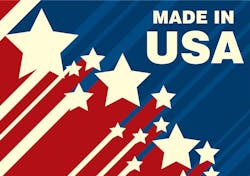Despite increased competition from providers whose products are manufactured in countries where labor costs are lower, “Made in America” is still more than just a tagline or marketing tool. A number of surveys have found that Americans not only are more willing to purchase U.S.-manufactured goods, but also tend to seek them out. For example, 78 percent of respondents in a survey conducted by the Consumer Reports Research Center indicated they would choose American-made products. According to a Boston Consulting Group survey, 80 percent of respondents said they are more likely to buy American, and are also willing to pay more for those products.
While these surveys reflect consumer opinion, this trend has also been seen in government agencies’ buying trends. Some of this can be attributed to the federal government’s longstanding requirements that preference be given to products manufactured in the U.S. These domestic preferences are designed to keep American-based manufacturers competitive while helping to grow the economy, improve national security and foster U.S. manufacturing.
But while these laws can help American-manufactured goods remain competitive with lower-priced products made overseas, they still cannot guarantee that agencies and contractors will choose to utilize U.S.-manufactured solutions. This leaves providers with a challenge: how to create demand for a product whose appeal goes beyond price?
While policy certainly contributes to government agencies increasingly relying on “Made in America” as a key part of the purchase decision-making process, there are five additional main factors that can drive growth of this trend: quality, flexibility, customer service, cost efficiency and economic impact.
Quality
The vital nature of security makes the quality and reliability of solutions critical. This is especially true for the government sector, where protected people, locations and assets can have significant impact on national security. If one facility, for example, is compromised, the impact could potentially have far-reaching consequences beyond that particular location.
In many industries, products manufactured in the U.S. are required to meet higher standards than those manufactured in China, Russia or other foreign countries where less stringent standards are used. This lends further support for American-made products’ well-earned reputation for superior quality.
Many American manufacturers have made significant investments in machinery, equipment and processes that allow them to produce solutions that deliver precision and standards that are impossible for some low-cost foreign-based manufacturers to attain. This further contributes to the overall quality of “Made in America” products, both in terms of perception and in reality.
Flexibility
Having been forced to compete with companies that benefit from lower labor costs in other countries, American manufacturers have invested heavily in advanced plants and technologies that provide greater flexibility. The best example of this can be seen in the way manufacturers approach customization.
Because every government facility and security installation is somewhat unique, each contains at least some area of operations that varies between locations or applications. Off-the-shelf solutions rarely provide the versatility each deployment requires.
Customization poses significant challenges for overseas manufacturers, whose profits rely on the ability to mass-produce and sell large volumes of standardized, commodified products. Because their entire manufacturing operations are built with this goal in mind, they are not equipped to handle requests for customization. Building an individualized version of their product would require them to stop a constantly-moving assembly line to reconfigure machinery and processes, which would significantly eat into profits.
Instead, customization of these solutions is typically left to installers or in-house technicians. But this type of on-the-fly customization is far from ideal for high-security government applications.
On the other hand, American manufacturers, in general, are heavily invested in the level of flexibility that gives them an edge in terms of providing individualized solutions. Better yet, given the customer-focused philosophy of many providers, these companies are more than willing to work with installers and end-users to develop innovative customized solutions, often without significant cost increases.
Additionally, as market demands and government requirements inevitably evolve and change, American manufacturers’ flexibility positions them to meet changing demands quickly and easily. Conversely, their lower-cost offshore counterparts will likely need to invest significant time and expense each time they have to overhaul their entire operations in order to mass-produce the innovative solutions end-users want and need.
Customer Service
American manufacturers have carefully cultivated a reputation for “getting it right” the first time, which gives customers the peace of mind that their solutions will work as intended from the moment they are deployed. Naturally, no one can guarantee 100 percent success 100 percent of the time, but providers of U.S.-manufactured products tend to do whatever it takes to make things right by their customers as quickly as possible. Having fast, easy access to service and support from the manufacturer as needed is a major benefit for government agencies, which can’t afford downtime or lost productivity, and goes a long way toward building trust in a particular manufacturer’s products.
Regardless of how robust a provider claims their service and support may be, that promise rings hollow if an end-user isn’t able to actually connect with the vendor. For those whose manufacturing operations are overseas, time differences and language barriers are two potential factors that can cause delays in providing timely response to customer issues; delays which compromise security. Government users must have reliable access to a provider when they need help the most – when something goes wrong and requires immediate attention. U.S.-based manufacturers are well-positioned to deliver this access, with smaller, more agile companies able to provide a dedicated team who customers can contact for service and support issues.
Cost Efficiency
While U.S. manufacturing remains more costly than overseas, the labor cost gap isn’t as wide as in the past, thanks to the combination of a strong U.S. dollar and policy changes in some foreign countries, such as China’s implementation of a program similar to Social Security. Although labor costs remain significantly lower overseas, allowing offshore companies to continue to offer their products at lower price points, American manufacturers are better able to compete on price today than at any other time in recent years.
Because they live and do business in the U.S, and are immersed in the day-to-day conditions, American manufacturers see and can often anticipate changing demands quickly. They can then change their approach to meet changing demands without incurring the type of expense that forces a provider to increase price points to recoup those costs, which is important for government customers, who are working with set – and often limited – budgets.
Economic Impact
Any discussion of the state of the U.S. or any other country will almost always include a look at the health of the nation’s economy. Naturally, buying American-made goods contributes in some way to improving the economy, which is a major reason “buy American” laws were enacted in the first place.
While the impact is most easily seen on a local level, where employment and a stable local tax base directly contribute to the economic success of municipalities, citizens and businesses, the positive effects have broader reach. The more quantitative benefits include the federal government’s ability to collect more income taxes, but there are also intangible benefits. For example, every “Made in America” success story gives other companies incentives to consider keeping or moving their manufacturing operations in the U.S., which further benefits local, state and federal governments and agencies.
While many providers may bemoan the availability of cheaply made, lower-cost foreign-made goods, the truth is that the availability of goods that are less expensive to manufacture has been a positive influence and change agent for U.S. manufacturers. The inability to compete on price with overseas manufacturers in recent years forced American companies to invest heavily in technologies and processes that deliver greater quality, flexibility, innovation and cost-effectiveness. Supplementing federal purchasing regulations and mirroring trends in consumer goods, the five main factors outlined above are improving the reputation of American manufacturing and delivering value that have led government agencies’ to more frequently select and purchase domestically-produced solutions.



